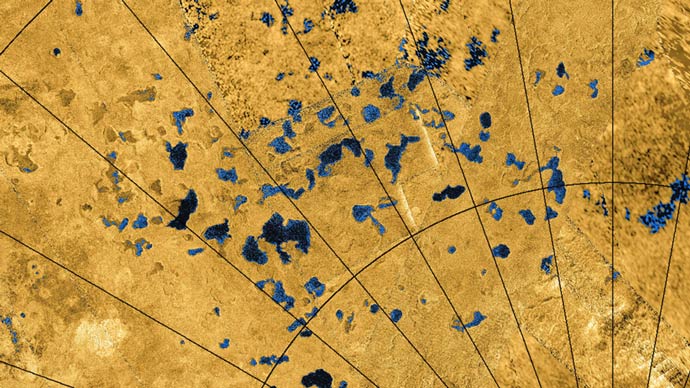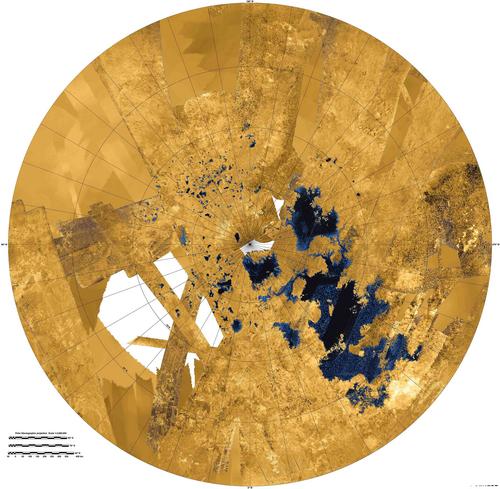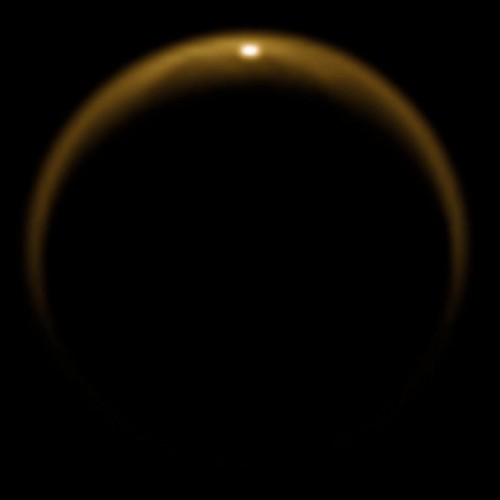
Saturn’s largest moon, Titan, has seas and lakes of liquid methane and ethane dotting its surface, but one question scientists have been trying to figure out is how the hollows in the ground, which hold the lakes, form to begin with. Now, a new study offers a solution: The depressions in the surface are formed in a process similar to sinkholes on Earth.
The study, from scientists at the European Space Agency (ESA), used data from the Cassini mission to determine that the depressions form as the surface is dissolved, in a manner similar to sinkholes and caves on Earth. The Titanian lakes are similar to karstic landforms, which result from the erosion of dissolvable rocks, such as limestone and gypsum. The rocks are dissolved by groundwater and rainfall over time, which leads to the formation of sinkholes and caves in humid climates, and salt-pans in more arid climates.

While there would of course be differences on Titan, the general process is thought to be similar. The research team, led by Thomas Cornet, calculated how long it would take these kinds of features to form on Titan. The result was that it would take about 50 million years to create a 300-foot (100-meter) depression at Titan’s polar regions, which are relatively rainy (liquid methane rain), which is consistent with the youthful age of the moon’s surface. At lower latitudes, with less rainfall, the time required was much longer—about 375 million years. This is also consistent with the relative absence of depressions in these geographical locations.
“We compared the erosion rates of organics in liquid hydrocarbons on Titan with those of carbonate and evaporite minerals in liquid water on Earth,” said Cornet. “We found that the dissolution process occurs on Titan some 30 times slower than on Earth due to the longer length of Titan’s year and the fact it only rains during Titan summer. Nonetheless, we believe that dissolution is a major cause of landscape evolution on Titan and could be the origin of its lakes.”
Cornet added, “Of course, there are a few uncertainties: the composition of Titan’s surface is not that well constrained, and neither are the long-term precipitation patterns, but our calculations are still consistent with the features we see today on Titan’s relatively youthful billion-year-old surface.”
As noted by Nicolas Altobelli, ESA’s Cassini project scientist: “By comparing Titan’s surface features with examples on Earth and applying a few simple calculations, we have found similar land-shaping processes that could be operating under very different climate and chemical regimes. This is a great comparative study between our home planet and a dynamic world more than a billion kilometers away in the outer solar system.”

The seas and lakes tend to be found near Titan’s poles—the north pole in particular. Generally, the lakes are not associated with rivers, but are thought to be filled by rainfall and liquids feeding them from underground. Some of them fill and then dry out again during the 30-year seasonal cycle on Titan. The lakes are shallow with rounded edges and steep walls, and are generally found in flat areas. The seas are much larger, up to several hundred miles (or kilometers) across and up to several hundred feet (or meters) deep, and are fed by branching, river-like channels. Titan’s seas are named after sea monsters in world mythology, with Kraken Mare being the largest at roughly 680 miles (1,100 km) long.
The study helps to highlight the similarities and differences between geological processes on Earth and Titan. Titan is the only other body in the Solar System known to have liquids on its surface, and the hydrologic cycle on Titan is reminiscent of the one on Earth, but the freezing temperatures and liquid methane and ethane instead of water make this a truly alien landscape.
Potential future missions to Titan include a probe which would float in one of the lakes or seas, or a small robotic submersible which could actually swim through the murky depths like a submarine on Earth. Such probes could sample and analyze the liquid hydrocarbons for organic material, which is already known to exist in large amounts on the surface and in the atmosphere.
Titan is also thought to have a salty subsurface ocean of liquid water, similar to moons like Europa and Enceladus and possibly others as well.
Whether there might be anything alive in those lakes and seas or the ocean is a whole other question, but more scientists are open to the possibility. It would have to be extreme life unlike anything on Earth, and likely based on methane instead of water, but the possibility is an intriguing one. What would Titanian life look like? Would we even recognize it as life?
There is also a great flyover animation of the northern lakes called Flying Over an Extraterrestrial Land of Lakes.
The new study was just published in the Journal of Geophysical Research, Planets.
More information about the Cassini mission is available here.
Be sure to “Like” AmericaSpace on Facebook and follow us on Twitter: @AmericaSpace





One Comment
One Ping
Pingback:Sinkholes on Titan: new study shows how hydrocarbon lakes may form by Earth-like erosion